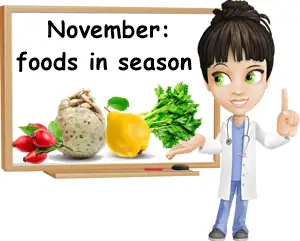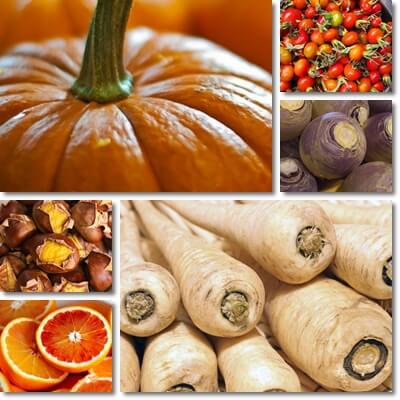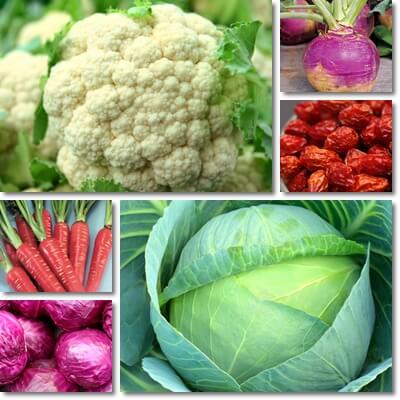So many healthy fruit and vegetables are in season in November. From cabbages of different colors to pumpkin, butternut squash, red, yellow, orange and purple sweet potatoes and carrots, chestnuts and healthy turnips and parsnip, but also kiwifruit and hawthorn, there’s a lot to choose from. Find out what are some of the best seasonal November foods you can eat and their biggest benefits for health.
Foods in season in November
Bananas
Bananas are available year-round, but some of the best tasting bananas are in season November through December. What makes bananas healthy is a good content of the antioxidant mineral manganese and an equally good content of dietary potassium and magnesium, two minerals with blood pressure lowering benefits. Bananas are naturally high in vitamin B6 known to help synthesize hemoglobin in red blood cells and improve its capacity to bind oxygen, with benefits for tiredness, fatigue, muscle weakness and anemia.

Broccoli
Broccoli is in full season September through November. Because it’s healthy and in season, which makes it more accessible price-wise, broccoli makes a great staple for fall-winter meals. Why eat broccoli? Broccoli contains organic sulfur compounds such as glucosinolates (isothiocyanates, sulforaphane) scientifically shown to exert anticancer effects against several cancers, including leukemia, colon and breast cancer. Broccoli is also an excellent source of vitamin C which is preserves almost entirely if minimally cooked, preferably steamed. Vitamin C has anti-inflammatory, anti-arthritic and immune-boosting benefits.
Brussels sprouts
Brussels sprouts are a seasonal fall-winter vegetable, available September throughout March. If you’re considering eating Brussels sprouts this November, here are some of the biggest benefits you can enjoy. Like other cabbage family vegetables, Brussels sprouts too are an anticancer food, rich in biologically active organic sulfur compounds with proven anticancer properties. Brussels sprouts are nutritionally-dense vegetables, high in vitamins C and K and a good source of vitamins B1, B6 and B9, potassium and magnesium with anti-inflammatory, antioxidant and immune system-boosting benefits and benefits for bones and teeth.
Cabbage
Cabbage is in season October throughout April in the Northern hemisphere, but peaks in October-November. What are the benefits of eating cabbage? Cabbages contain organic sulfur compounds, naturally occurring chemicals with scientifically proven anticancer properties. Glucosinolates in white, green, red and purple cabbage have demonstrated anticancer activity against a number of cancers, including leukemia, colon and breast cancer.

Carrots
The second major carrot harvest of the year starts at end of summer-beginning of fall, with some of the best tasting carrots being available right now, in November. Choose regular orange carrots for a boost in beta-carotene with vitamin A activity and benefits for eyesight. Choose red carrots for lycopene and its antioxidant and blood pressure lowering benefits. Choose purple carrots or black carrots and you’ll be getting pigmented anthocyanin antioxidants with scientifically-proven anticancer properties. Or choose yellow carrots that have lutein and zeaxanthin antioxidants which studies show reduce risks of cataract and AMD (age-related macular degeneration or loss of vision).
Cauliflower
A cabbage family vegetable in season in November, cauliflower boasts anticancer properties stemming from its content of organic sulfur compounds. Cauliflower comes in several color, including white, purple, orange and green. Each color is indicative of different pigmented antioxidants with varied benefits for health. For instance, purple cauliflower contains anthocyanin antioxidants with scientifically proven anticancer properties. Cauliflower is a good source of vitamin C at over 50% of daily recommended intakes per 100 g, but should be minimally cooked, preferably lightly steamed in order to preserve its vitamin C content.
Celeriac
Celeriac is a fall-winter staple vegetable popular throughout Europe, especially in Balkan countries. Celeriac is essentially the knobby, bulbous stem of the celeriac plant, a variety of celery grown not for its leaves, but for its root-like bulbs. Peak season for celeriac is October-November, although it is available throughout fall and winter. What’s so good about celeriac? While it is a common allergen, celeriac is high in vitamin K which has anti-inflammatory benefits and benefits for calcium metabolism, helping direct calcium into bones and reducing risks of osteoporosis and arterial calcification.
Celery
There are two harvest seasons to celery, one being September through April. While celery is not the most eye-catching of November vegetables, and is a common allergen, it is a good source of nutrition. The darker the stems and leaves, the more nutrients in your celery. Eat celery if you are looking to get more vitamin K, vitamins B5, B6 and B9 and potassium. However, know that Western celery leaves which are light green due to trenching and blanching are less nutritious than celeriac and Chinese celery.
Chestnuts
Chestnuts are in season October through November and a great fall staple. Chestnuts are high in vitamins B1, B6 and B9 with benefits for anemia and combat fatigue and muscle weakness, and a good source of potassium for high blood pressure. Chestnuts are a good food for pregnant women, supporting the normal development of the baby during pregnancy thanks to its good vitamin B9 content. Chestnuts are gluten-free so you can use them to make a gluten-free chestnut flour to serve as a baking flour for anything from bread and flat-bread to pound cakes and pancakes.

Citrus fruit
Many citrus fruit start their season in November which then lasts until February, March or May, depending on the fruit and region. Oranges, tangelos, mandarins or mandarin oranges, but also pomelo and grapefruit, whether it’s white, pink or red, are all in full season in November. Citrus fruit such as pink and red grapefruit are rich in the antioxidant lycopene which has blood pressure lowering benefits and anticancer properties. Blood oranges are high in anthocyanins with scientifically proven anticancer properties.
Choose mandarin oranges or acidless oranges if you have gastritis or a stomach ulcer. Choose oranges or tangelos over grapefruit if you have diabetes and are on anti-diabetic medication, and avoid grapefruit juice completely. For extra flavor with a pregnancy sweet and sharp citrussy taste, go for Minneola tangelos, or even Orlando tangelos instead of ordinary oranges.
Cranberries
Cranberries are the fall fruit, in full season in November. Make your own juice from fresh cranberries to fight frequent UTIs as cranberries contain proanthocyanidin antioxidants which help reduce the frequency and length of urinary tract infections, as well exert a preventative action against UTIs. You can buy cranberry vitamin C supplements for a healthy dose of natural vitamin C with immune-boosting properties.
Fennel
The bulbous Florence fennel is in season in October, November and all throughout winter. The white-and-green fragrant bulbs with anise, dill and licorice flavors and a delicate sweet taste are a decidedly Mediterranean choice, popular in Italian cuisine in particular. What makes fennel good to eat? The bulb is low in calories with only 31 kilocalories per 100 g, and thus a good food for losing weight. Fennel fruits, best known as fennel seeds, can be eaten as such or used to make tea and have carminative properties, helping eliminate gas and associated bloating and discomfort, and antispasmodic properties.
Grapes
November is last call for seasonal grapes. Late-season grapes are still healthy and rich in antioxidants. Choose darker colored grapes such as pink and red grapes for a boost in antioxidants such as proanthocyanidins which help prevent and reduce the severity of urinary tract infections. Choose blue, purple and black grapes and get loads of anthocyanin antioxidants with anticancer properties. For more benefits, eat your grapes with skin and seeds, unless you have diverticulosis.
Hawthorn berries
Hawthorn berries are the fruits of the hawthorn plant and they’re in full season in November. Because they’re not very palatable, hawthorn berries are best used to make hawthorn tea, a sharp-fruity herbal tea with benefits for cardiovascular health. Hawthorn berry tea is good for congestive heart failure, improving blood flow to and from the heart, and associated symptoms such as chest pain (angina pectoris). Hawthorn berries and berry tea help lower blood pressure and are effective against arrhythmia. You can sweeten your hawthorn tea with raw hawthorn honey.
Kiwifruit
Kiwifruit is available year-round, but California kiwifruit is in season September through November. Eat raw kiwifruit for a boost in vitamin C: a serving of only 100 g of fresh kiwifruit gets you between 100% and 200% of your daily vitamin C requirements. Vitamin C is a known immune-booster, anti-inflammatory and antioxidant vitamin. It also has antiaging benefits, stimulating production of collagen for better skin elasticity. Choose yellow kiwifruit for more vitamin C, green kiwifruit for more vitamin K or kiwi berries for a beautiful display of nutrition.
Leek
Leek is like a more mild-tasting, stout green onion-type of vegetable in season November through April. Leek is a great source of vitamins B6, B9 and iron and has anti-anemia benefits, supporting red blood cell production and boosting vitality. Leek is a good food to eat during pregnancy thanks to its content of vitamin B9 which is known to reduce neural tube defects of the brain, spine and spinal cord in babies.
Parsley
Leaf parsley, that is, parsley eaten for its leaves is still in season in November. The aromatic herb is an extreme source of vitamin K with benefits for blood coagulation and teeth and bones. Parsley is high in vitamin B9 and iron and has anti-anemia benefits, and is a great source of vitamin C to boost iron absorption. Parsley further has blood pressure lowering properties and benefits for eyesight.
Parsnip
Of all the vegetables in season in November, parsnip is one of the healthiest. Despite its rather bland taste and unimpressive flavor profile, parsnip has good nutrition and several impressive health benefits. Parsnip is a good source of vitamins C, E, K and B9, as well as manganese, phosphorus, magnesium and potassium. It helps lower blood pressure, exerts anti-inflammatory benefits and is good for pregnant women, supporting the normal development of the baby during pregnancy. More important, parsnip is a source of chemicals such as falcarinol, farcalindiol, methyl-falcarindiol and panaxydiol with scientifically proven anticancer properties.
Pecans
Pecans start ripening in late September-early October and continue to do so all of November and up until early December. In other words, November is the time to harvest your pecans as they are in full season. The culinary nuts are one of the healthiest fruits in season in November. Pecans are an extraordinary source of the mineral manganese needed for bone and teeth formation and for the good functioning of the innate antioxidant defense system of the human body. Pecans help lower blood pressure numbers and improve mood with the help of magnesium, boost immunity thanks to a good zinc content and combat fatigue and weakness via B vitamins.
Pumpkin
Pumpkin is a winter squash and one of the healthiest botanical fruit and culinary vegetables in season in November. The bright orange pulp is full of pigmented carotenoid antioxidants with vitamin A activity, notably beta-carotene. Eating pumpkin is good for eyesight, promoting good visual acuity and color vision, and keep the mucous membranes of the eyes, nose, throat, lungs and GI tract healthy. Pumpkin contributes to the immune system and relives constipation naturally. And you can eat it whole, pulp, seeds, leaves, flowers and pumpkin rind.
Quinces
November is last call for quinces. The bulky, mouth-drying fruit is in season October through November and makes for the most exquisite fruit jam. Quince may make your mouth pucker, but they are a staple for anyone with digestive issues. You can bake, boil or steam quince, sweeten with your favorite healing honey varieties or sugar and cinnamon and enjoy as a dessert. Or you can boil, steam, bake, roast or stew quinces for an original side dish that is easy on the stomach if you have acid reflux, gastritis or a stomach ulcer.
Radishes
Supermarket and farmer’s market stands are full of radishes in November. While pink radishes are not true seasonal November vegetables as they’re cultivated almost year-round, they are available as a fall veggies September through November. Winter radishes such as black radishes on the other hand are a true seasonal fall and winter vegetable, largely available November through March.
Radishes contain naturally occurring sulfur compounds with anticancer properties and demonstrate antibacterial and detoxifying benefits. Radishes are also good sources of vitamin C to boost immunity during the cold season and have good amounts of several B vitamins, including vitamins B6 and B9 which combat anemia and associated tiredness and muscle weakness.
Rose hips
Rose hips are the fruits of rose plants and start to ripen in October, but can be harvested throughout the fall and well into winter as frost makes the fruit more mellow. But November is a great month to forage for rose hips for tea. Rose hip tea is a medicinal herbal tea with antioxidant and anti-rheumatic properties and benefits for blood pressure and skin. Find out more about the benefits of rose hip tea and how to make it yourself at home.
Sea-buckthorn
Sea-buckthorn berries are in season all of November, but can be harvested well into December. The medicinal berries can be used to make sea-buckthorn berry oil, a therapeutic carrier oil used for skin care, and for its anti-inflammatory and cardiovascular benefits. You can also make a therapeutic sea-buckthorn tea with antioxidant, anti-inflammatory and anti-hypertensive properties and benefits for insomnia and anxiety.
Star fruit
Star fruit (or carambola) is a healthy fruit in season in November. In fact, star fruit is available October through December, this being one of its two major harvesting seasons. Star fruit is low in calories at only 31 kilocalories per 100 g and can help with weight loss. The fresh fruit is a good source of vitamin C at around 40% of daily requirements and provide antioxidant and anti-inflammatory benefits.
Sweet potatoes
A fall-winter staple vegetable, the sweet potato is in full season in November, just in time for Thanksgiving, but continues its season throughout December. Orange-fleshed sweet potatoes are high in pro-vitamin A beta-carotene with benefits for eyesight and immunity. Purple sweet potatoes contain anthocyanin antioxidants with anticancer properties. Whichever sweet potato color you may choose, you are sure to enjoy some wonderful benefits for health.
Turnips
Turnips are in season October through March, but November is a great month for them. The turnip root is modestly nutritious with good amounts of vitamin C and a low calories content. Turnip greens or leaves on the other hand are nutritionally-dense, rich in vitamin K and other essential vitamins and minerals. An extreme source of vitamin K, turnip greens help build strong, healthy bones and reduce risks of osteoporosis and cardiovascular disease by binding calcium to bones rather than soft tissues such as heart valves. Turnip greens are anti-inflammatory, but are best eaten in small amounts if you have issues with blood clots. The leaves are high in the antiaging vitamins A, C and E and a good source of vitamin B9.
Walnuts
Walnuts are harvested September through October, November being last call for the Omega-3 rich nuts. Walnuts are an excellent source of the antioxidant mineral manganese, and a good source of calcium, iron, magnesium and phosphorus with benefits for high blood pressure, anemia and bones and teeth. A generous source of B vitamins, walnuts boost energy levels and contribute to red blood cell production. The vitamin B9 and Omega-3 and Omega-6 content of walnuts makes them good for pregnant women, supporting the normal development of the baby during pregnancy.
Winter squashes
Just like pumpkin, winter squashes are in full season in November and one of the healthiest food options. Butternut squash, acorn squash and most winter squashes tend to be high in pigmented beta-carotene and other carotenes with vitamin A activity and are good for vision, skin and immunity. Winter squashes have natural laxative properties and help relieve constipation, and are a good source of potassium with blood pressure lowering benefits.

